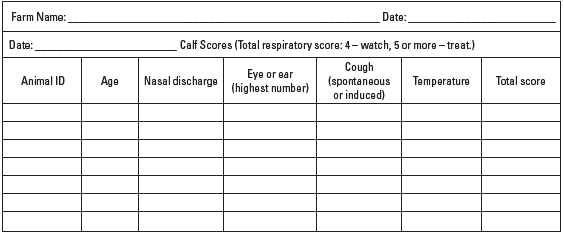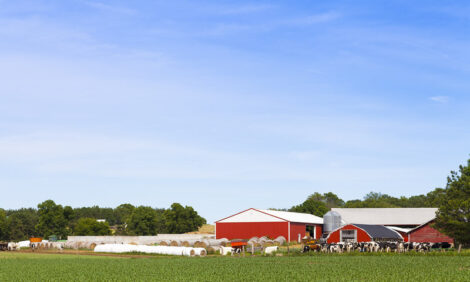



Respiratory Disease In Young Dairy Calves
Respiratory disease is the second leading cause of death losses (scours is the first) in unweaned heifer calves, according to Alvaro Garcia, Extension dairy specialist, and Russ Daly, Extension veterinarian.
Respiratory problems have increased by 34 per cent in the last 20 years, causing nearly 21 per cent of all newborn calf losses. Heifers that survive continue to perform poorly as adult cows. In order to prevent this costly problem, it is important to address both determinant and predisposing causes.
Predisposing Causes
Passive Immunity – To be able to survive the microbial challenges posed immediately after birth, a calf must have built-up adequate immunity. As there is little time to develop its own immune system, the calf needs to rely on the passive immunity received from the dam through colostrum.
To guarantee that colostrum feeding transfers passive immunity, the four key attributes of colostrum feeding—quality, quantity, quickness, and cleanliness—must be observed.
Current guidelines suggest calves should receive 3–4 quarts of high-quality colostrum within 1 hour of birth and 3 additional quarts in 12 hours. If colostrum ingestion is inadequate, esophageal feeders can be used making sure that 3–4 quarts are administered within 1 hour of birth. The majority of the dairies in the US feed colostrum to calves from either a bucket or a bottle. Pooling colostrum is also becoming popular with these farms because it increases the immune competence of the calves (or their ability to respond to a more diverse pool of pathogens). When pooling colostrum, care must be taken to ensure not to include colostrum either from cows having Johnes or from 1st calf heifers.
One way to find out if colostrum has supplied adequate amounts of immunoglobulins (IgG) is to measure either IgG directly or serum total protein in blood serum. Serum total protein measured with a refractometer is highly correlated with serum IgG levels. Measuring serum total protein in a group of calves is more meaningful than individual readings. At least 80 per cent of a group of calves should have serum protein levels of 5.5 g/dL or higher.
While timely colostrum administration is critical, so is proper handling, as colostrum can be an ideal growth medium for bacteria. If colostrum is not going to be fed immediately, it is very important to refrigerate or freeze the colostrum as soon as possible. A recent study of Minnesota and Wisconsin dairies has shown that the mean total bacteria count and total coliform count in over 200 colostrum samples collected was 16.1 million and 2.7 million cfu/ml, respectively. Thus, the first approach should be to collect colostrum under strict sanitary conditions and cool the colostrum as soon as possible.
Some producers are evaluating the possibility of on-farm pasteurisation to make colostrum safer. Research trials have shown no difference in colostral IgG concentration between raw and pasteurised colostrum. What’s really important though is that the trials have also shown a reduction in the mean total bacteria counts at time of feeding (813 and 40,738 cfu/ml for pasteurised and raw colostrum, respectively. In addition, calves fed pasteurised colostrum had higher IgG levels in blood (22.34 mg/ml and 18.07 mg/ml for pasteurised and raw colostrum, respectively).
If pasteurisation is going to be used, a batch pasteuriser is recommended, as it uses relatively lower temperatures and a longer heating time (60°C for 60-120 minutes) without risking denaturing the immunoglobulins and thus reducing colostrum quality. Due to the cost of the equipment, this alternative is mostly reserved for large dairy operations that have to feed greater numbers of newborn calves at one time. Needless to say, milk pasteurisers can also be used for waste milk, which reduces the costs of using milk replacers.
Environment — Raising calves in barns is convenient because it protects the calves and the employees from adverse weather. The problem is that stationary, warm air can contain potentially harmful gases (i.e., ammonia), odor, dust, and microorganisms (e.g., fungal spores, viruses, and bacteria). Ammonia and dust can reach the alveoli of the calf’s lung and cause irritation and inflammatory reactions. Dust particles oftentimes carry microbes that can reach respiratory tissues where they can multiply. This association between respiratory diseases and air quality in confinement environments has been recognised for a long time.
Other factors that increase the risk of respiratory disease are shared housing with cows during the first week of life, more than 2 months difference in age within a group, previous episodes of diarrhea compared with none, and leaving calves with dams for more than 24 hours post calving. Maintaining clean-and-dry quarters for all calves is of utmost importance to reduce the incidence of respiratory disease.
To reduce bacterial numbers in the environment, important management measures, such as increasing pen area and decreasing pen temperature, can be taken (table 1). Increasing pen area results in less microbe concentration per surface unit and thus less challenge for the calves. Cold-temperature housing has also beneficial effects, as bacterial growth is reduced under cold conditions. A recent experiment compared calf performance under cold (40.5°F) and warm (59.9°F) indoor environment. Calves were fed 1 pound per day of a non-medicated milk replacer that contained 20 percent protein and 20 percent fat. Environmental temperature had no effect on scour scores, days scouring, and electrolyte costs. Calves subjected to cold conditions consumed more grain starter, which resulted in similar growth rates between both environments.
|
Table 1. Steps to reduce prevalence of respiratory disease
|
|---|
|
This demonstrates that calves need additional nutrients when cold-temperature barns are used. The performance success of calves in cold housing thus depends on administering adequate nutrition.
Adequate ventilation is critical to reduce not only bacteria counts in the air but also ammonia concentration, which irritates the respiratory tract. However, producers have to be able to differentiate between proper ventilation and drafts that result in cold stress. In a recent experiment, the absence of drafts was associated with reduced risk for diarrhea and respiratory disease.
A calf that is in its thermoneutral zone will not resort to energy-production or energy-saving mechanisms to cope with cold stress. Producers can check the calves to verify that cold-coping strategies such as shivering or pilo-erection (hair rising) have not been set in motion by the body. Checking the depth of the hair coat in calves is a good, practical way of assessing mild cold stress that has not elicited shivering. At environmental temperatures of 73°F, the depth of the coat can be nearly half an inch, whereas when pilo-erection occurs in response to cold the depth of the coat will almost double.
To cope with cold weather, calves need adequate nutrition and dry, well-insulated surface to rest on. Characteristics desired in bedding sources for calves are good moisture absorbance and the ability to keep the body warm. One study found that wheat straw had the warmest surface temperature, rice hulls and wood shavings had intermediate temperature, and sand had the lowest temperature. The concentration of ammonia at 4 inches above the bedding was also lowest for long wheat straw. Another study also found wheat straw to be warmer, and although it supported greater bacterial counts than wood products (i.e., shavings or sawdust), it appeared the bacterial problem was overcome by the straw improving calf nesting and thus environmental temperature control.
Determinant Cause: Microorganisms
Assuming calves have received adequate immunity through colostrum, the next important step it to reduce the microbial challenge. In order to accomplish this, the calf has to be removed from the dam as soon as possible. Calves should be placed in their own quarters in individual pens that help them avoid nose-to-nose contact with other calves. This environment should help the calves cope with stress by reducing exposure to pathogens from the cow and other calves. There should be ample dry bedding that will provide comfort and insulation from the cold. Be sure to avoid bedding materials that will result in dust (e.g., sawdust), as dust irritates the respiratory tract and facilitates the attack by bacteria.
Numerous vaccines are marketed for prevention of clinical respiratory diseases in cattle. Traditional views have held that the antibodies the calf receives through colostrum usually cause vaccines given to a young calf to be ineffective. More recent research indicates that, in certain instances, modified live viral vaccines stimulate a protective response in calves challenged with these agents, despite the inability to measure an active antibody response in the calf’s bloodstream. An example of this protection is the use of intranasal IBR/Pi3 vaccines in calves less than 1 month old.
Other work has demonstrated that modified live virus BVDV vaccines provide protective immune responses to disease challenge when given to calves as young as 6 weeks of age. Little has been published regarding the effectiveness of vaccines against bacterial pneumonia pathogens such as Pasteurella multocida, Mannheimia hemolytica, or Mycoplasma bovis when administered to very young calves. Vaccine programs for calves against respiratory disease pathogens should be developed with advice from a veterinarian.
Detection of respiratory disease
To measure the success of the colostrum program, it is useful to have some benchmarks of calves morbidity and mortality. Less than 25 per cent of calves should be affected by disease (morbidity), and the death rate should be less than 5 per cent.
In order to evaluate the severity of the respiratory disease, some research suggests a respiratory score based on rectal temperature, the characteristics of the nasal discharge, eye or ear appearance, and presence of cough (fig. 1). The score is the sum of points from the four categories of clinical signs (temperature, cough, nasal discharge, eye or ear), where the higher the value indicates greater severity (fig. 2). Calves are considered sick when they score 6 or greater and present two or more clinical signs of respiratory disease.
Figure 1. Scoring system for calf respiratory disease

Figure 2. Calf Health Scoring Criteria

Treatment and prevention
Once clinical signs of respiratory disease become evident in a calf, appropriate antibiotic therapy is warranted. Antibiotics will not affect viral infections; instead, antibiotics are directed against primary or secondary bacterial infections such as Pasteurella, Mannheimia, and Mycoplasma.
A wide variety of effective antibiotics are available, mostly as prescription drugs that may be obtained when a valid veterinary client patient relationship exists. Antibiotics typically considered effective against respiratory infections include tetracycline, florfenicol, ceftiofur, tulathromycin, and enrofloxacin, among others. Treatment is most effective soon after clinical signs are detected; medication failures are not uncommon when treatment is not initiated until late in the course of disease. Other supplemental treatments such as anti-inflammatory drugs may also be of benefit.
Treatment decisions should be made with veterinary input and with the use of diagnostic bacteriologic sensitivity results, if available.


